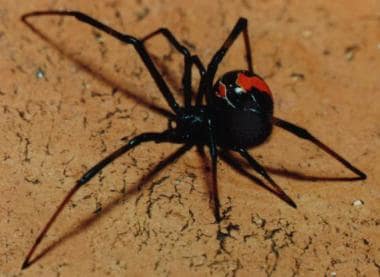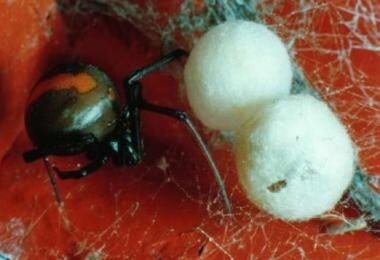Practice Essentials
The redback spider (Latrodectus hasselti) belongs to the family Theridiidae, the comb-footed spiders. Its genus Latrodectus also includes black widows, whose name may be more familiar to North American readers. The redback spider can be found throughout Australia, although it is more commonly seen in the temperate regions than in the colder, southern areas. The spider exists in higher numbers in Australia's urban and suburban areas and is virtually absent in the continent's forests. Outside of Australia, similar species of Latrodectus include Karakurt in Central Asia, Malmignatte in Europe, the Koppie spider in South Africa, and the Night Stinger in New Zealand.
The redback spider bite is the most common envenomation treated with antivenom in Australia. The female redback spider is responsible for most envenomations. She is usually 10 mm in length and has a small cephalothorax and a large, globular abdomen that bears a red, orange, or brown stripe. The male redback spider is considerably smaller than the female and is only occasionally able to cause mild envenomation. [1, 2] See the images below.
 Female redback spider showing a distinctive red stripe over the abdomen. Image courtesy of John Paterson.
Female redback spider showing a distinctive red stripe over the abdomen. Image courtesy of John Paterson.
See Medically Significant Spider Bites: Which to Watch Out For, a Critical Images slideshow, for help identifying and treating various envenomations.
Prognosis
Most patients with redback spider envenomation recover fully. Accurate data regarding morbidity/mortality is difficult to gather, as there is no mandatory reporting of spider bites in Australia. There appears to be greater morbidity in pediatric and elderly patients. There have been no recorded deaths caused by redback spider bites in the past several decades. [3]
History
The only way to definitively diagnose a redback spider bite is by positive identification of the spider, either by patient description of the typical red markings or if the spider or a digital photograph of the spider is brought to the provider. [4]
Also see Presentation.
Diagnostics
There are no specific laboratory studies available to diagnose latrodectism.
The serum creatine kinase, serum glucose, alanine transaminase, aspartate transaminase, and peripheral white blood cell count may be elevated, [5] but these findings are nonspecific and generally unhelpful.
In a female patient, a pregnancy test should be performed to differentiate the presentation from premature labor or other complications of pregnancy and to guide the medication choice for treatment of latrodectism.
Plain radiographs of the affected limb may be indicated to evaluate for subcutaneous air if a concern for necrotizing fasciitis exists.
Venous Doppler ultrasonography of the affected extremity may be indicated to evaluate for deep vein thrombosis if the diagnosis is unclear.
A 12-lead electrocardiogram should be obtained in patients with autonomic instability, chest pain, or if comorbidities are present.
Treatment
See Treatment and Medication.
Prevention
Use of pesticides may prevent exposure to spiders in the home. In endemic areas, patients should be advised to inspect their clothes and shoes for spiders before wearing them.
Long-term monitoring
Patients should be given thorough instructions listing the symptoms of serum sickness (fever, pruritus, and arthropathy) and cellulitis and advised to seek medical care if such symptoms occur. [1] Patients may need to undergo a short course of steroid treatment should serum sickness occur.
Pathophysiology
The redback spider can cause a clinical condition referred to as latrodectism following a bite. The active ingredient in the redback's venom responsible for its toxic properties in vertebrates is a 130-kd protein, alpha-latrotoxin (aLTX). aLTX is a potent neurotoxin that works in 2 ways to produce efflux of neurotoxins from presynaptic nerve cells.
In one mechanism of action, aLTX aggregates into tetramers that form pores in neuronal presynaptic cell membranes allowing calcium influx into the cytosol and resulting in exocytosis of neurotransmitters such as norepinephrine, dopamine, acetylcholine, glutamate, and GABA. The membrane pores formed by aLTX may also be large enough for a direct efflux of small intracellular compounds that are vital for cytoplasm function.
The monomeric aLTX can also act by activating latrophilin (LPH), an aLTX receptor found on the cell surface of neuronal cells, without incorporating into the cell membrane. Latrophilin is a G protein-coupled receptor that activates phospholipase C, which, in turn, increases the cytosolic concentration of IP3 leading to release of calcium from intracellular stores. This rise in cytosolic calcium increases the rate of spontaneous exocytosis of neurotransmitters and the amplitude of evoked release. Alpha-latrotoxin is a potent venom, with an LD-50 of 20-40 µg/kg of body weight in mice. [6, 7, 8]
Epidemiology
Frequency
United States
Only the black widow spider, a close relative of the redback spider, lives in the United States. These arachnids cause approximately 2500 envenomations each year.
International
The redback spider is found in Australia, New Zealand, and southern Asia. In Australia, the spider has been blamed for 250 envenomations requiring antivenom annually. Perhaps many more cases are mild or unrecognized and do not receive antivenom.
Race
All races are susceptible to redback spider envenomation if the patient lives in an endemic area inhabited by the redback spider. One article shows more severe envenomation in Aboriginal patients but states that this is due to a significantly longer time from envenomation to presentation in ED as compared with non-Aboriginal patients. [9]
Sex
In one study of redback envenomations in Australia, 60% of victims were female. However, most sources do not demonstrate a male/female sex discrepancy. [4]
Age
Redback envenomation may occur at any age; the median age is 35 years. Envenomation may be more dangerous in babies and small children because of the difficulty in making a specific diagnosis in that group of patients in addition to the small body size bearing the same dose of injected poison as an adult would tolerate. [4]
-
Female redback spider showing a distinctive red stripe over the abdomen. Image courtesy of John Paterson.
-
Female redback spider with egg sacs. Image courtesy of John Paterson.
-
Female redback spider. Image courtesy of John Paterson.
-
Female redback spider. Image courtesy of John Paterson.










